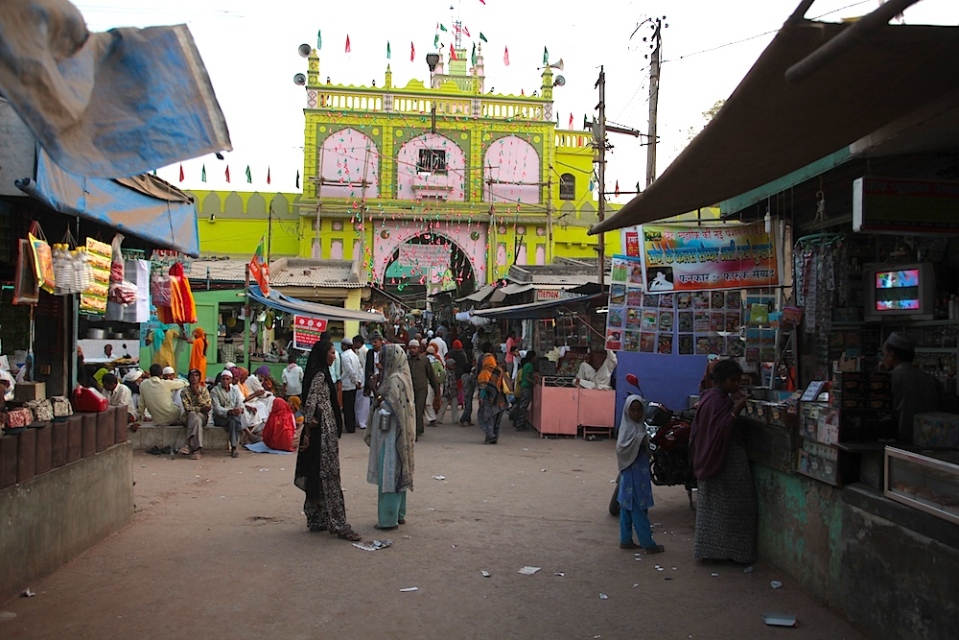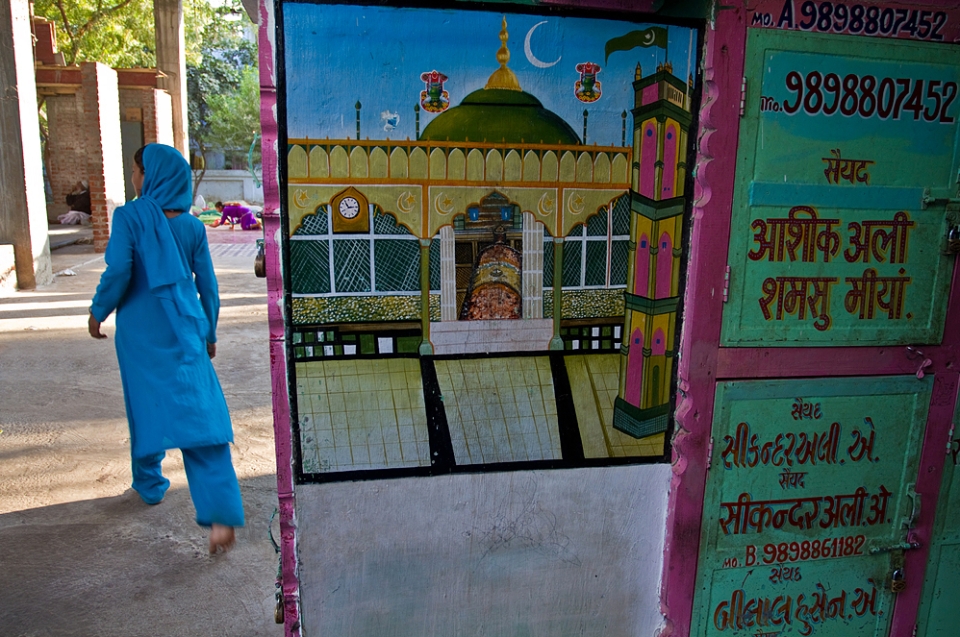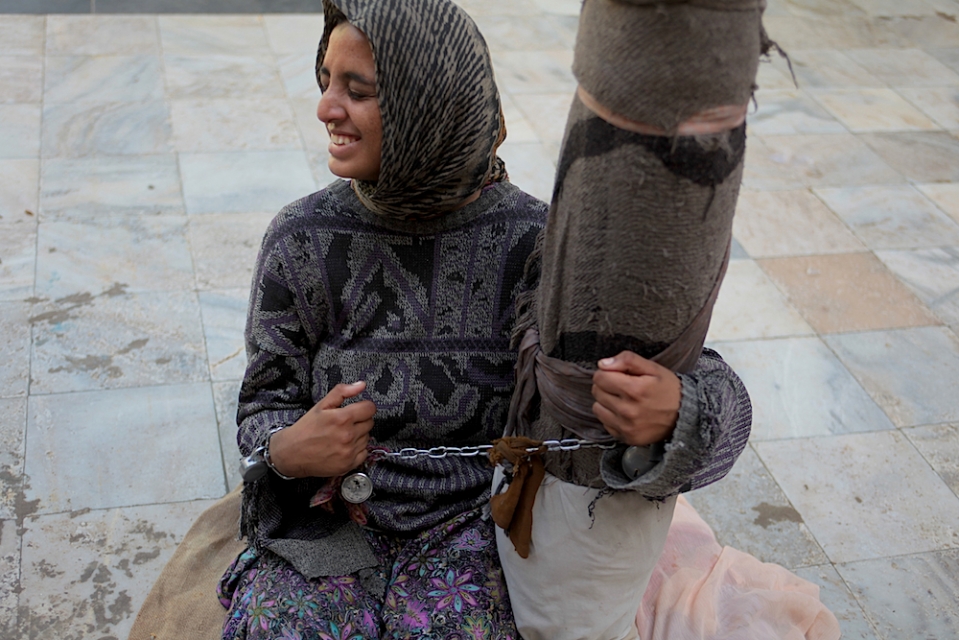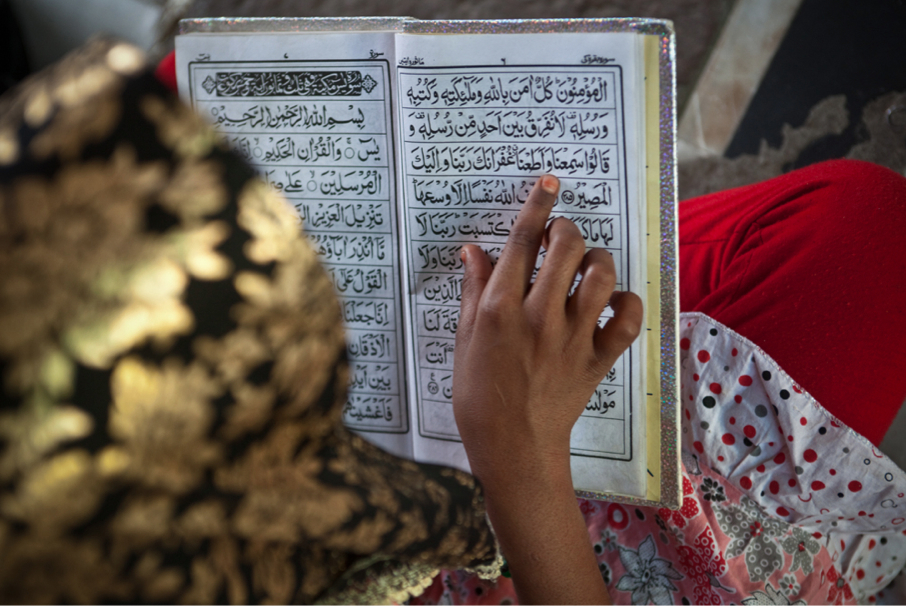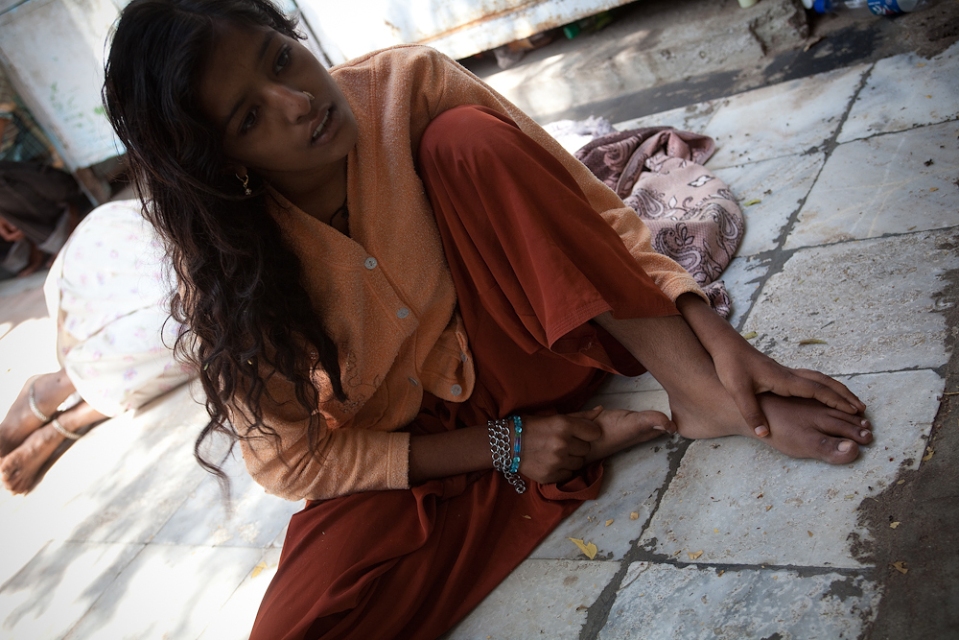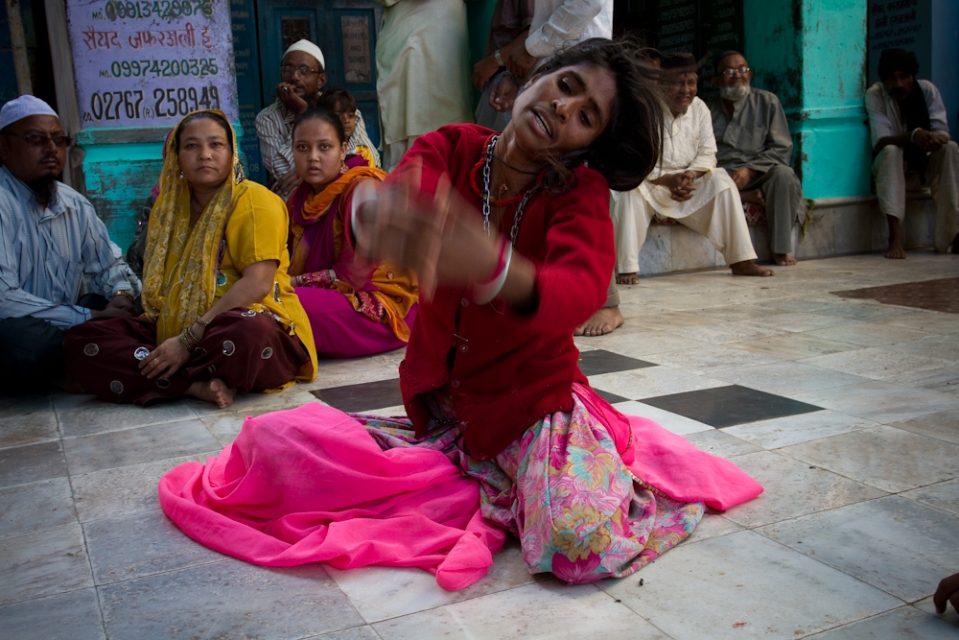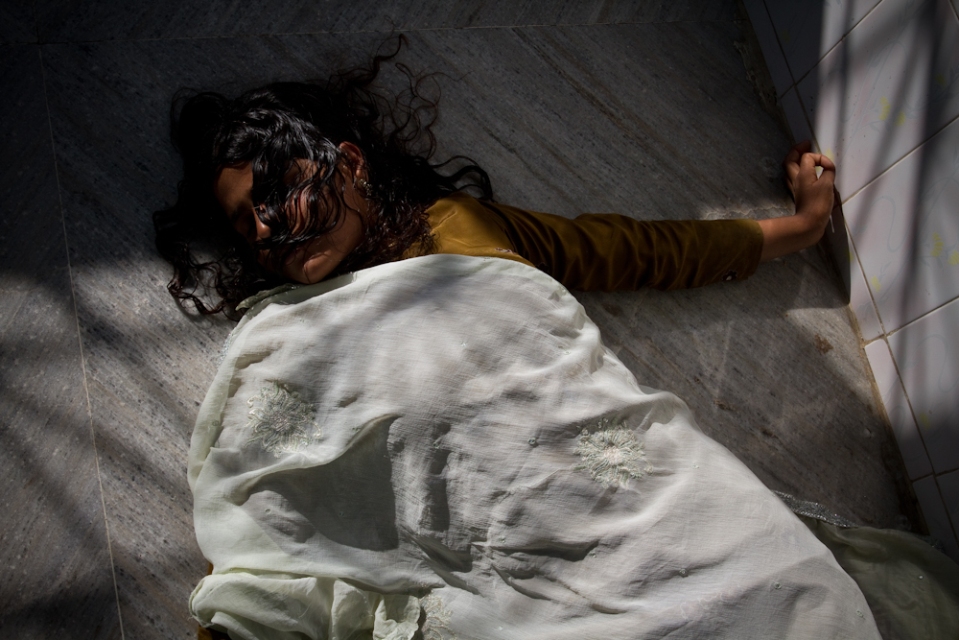Main Entrance of The Shrine of Hazrat Ali Mira Datar-Photo © Tewfic El-Sawy-All Rights Reserved
Sufis brought their brand of Islam to the Indian subcontinent by walking from the west; from Afghanistan and Iran. These Sufi ascetics walked around India, and eventually settled in towns and villages, counseling and helping people. These ascetics became saints or “pirs” as they’re called. When the ascetics died, their tombs became dargahs, sacred shrines.
The type of Islam brought to the subcontinent by these Sufis was more flexible, and considerably more tolerant than mainstream Islamic orthodoxy. This tolerance appealed to people of other religious faiths and traditions, especially as they could syncretize their age-old beliefs with this type of Islam. Islam was also an egalitarian religion; doing away with the restrictive caste system prevalent in India, further enhancing its popularity amongst the poor and the lower caste. Studies have shown that Indian Sufism is an Indian phenomenon, not just a Muslim phenomenon, so syncretism will be mentioned on this blog quite frequently. Having seen syncretic elements between Hinduism and Sufi traditions at all the dargahs I’ve been to, I was not surprised in reading that imported Muslim medicinal traditions were merged into Hindu traditional medicine; an important factor in the historical interweaving of these religious traditions in the subcontinent.
The first two Sufi orders were established in the 1200s during the Sultanate of Delhi. These were the Chisti and the Suhrawardi orders. The former was founded by Muin-Uddin Chisti, who died in 1233, and was one of the leading spiritual leaders of India. His shrine in Ajmer (Rajasthan) is a revered pilgrimage destination for Muslims of South Asia.
I always try to photograph at the two main dargahs in Delhi when I’m there. I prefer the Nizzam Uddin shrine over Qutb Uddin…perhaps because of the warren-like alleys that lead to its mosque. Attending a qawwali performance at the Nizzam Uddin dargah that are held every Thursday evenings, along with hundreds of visitors-pilgrims, is a spiritual-musical spectacle that I greatly enjoy. It is here at Nizzam Uddin that I first witnessed a trance, a hazri or hajri, when a woman suddenly began shaking and emitted sob-like sounds. Her family sat nearby, ashamed by her condition but resigned to do whatever it took to heal her emotional discomfort.
Decorative Panel And Lockers-Dargah of Mira Datar- Photo © Tewfic El-Sawy-All Rights Reserved
Though seeing trances at Nizzam-Uddin introduced me to the ritualistic tradition (if I can call it that) of hajri, it was an article in The New York Times that led me to the shrine of Sufi saint Bahadur Shaheed in the most Hindu of all India’s cities, Varanasi. How more syncretic can that be? A Sufi Muslim shrine visited by thousands of Hindus, Muslims and Sikhs in the very heart of Hinduism’s holiest of cities. There as well, Hindu and Muslim women went into violent trances, and exhausted, fell to the ground. Hindu women with red vermillion powder in their hairline and Muslim women, faces obscured by the niqab, were united in their supplications to the Sufi saint. One of the women in a state of extreme trance reached for a stone when I approached her too closely, but was restrained by those around her. Others in a similar state ignored, or just didn’t see, me.
The origins of Bahadur Shaheed are murky. He was probably a Muslim soldier from the 11th century who came with an army to conquer Varanasi, and lost his life here. Perhaps it was because of his death as a martyr of sorts that he’s considered to be a saint. Much later, I come to know that martyrdom is a recurrent theme with such saints…and the more gruesome the martyrdom, the higher the status. To my mind, an example of syncreticism between Islam and Christianity.
I spent two whole days at the shrine of Bahadur Shaheed in 2006, and it was my “baptism of fire” to these exorcisms at Sufi shrines. The shrine itself is in the courtyard of a mosque…a simple building, with a double spire painted green, and not far from a Catholic church. The courtyard was full of people, families and a noticeable number of women. Some women were disheveled, with long matted hair, yelling “Baba…Baba” pleading to the Sufi saint. Around the corner from the shrine, groups of women and children, not allowed to enter the inner tomb, were tying red threads and pieces of colored cloth to the marble trellises of the shrine, while mumbling supplications, hoping that prayers answered. Outside the periphery, vendors sold rose petals, kewar water and incense as offerings to the saint.
Devotee-Shrine of Mamu Shaab -Photo © Tewfic El-Sawy-All Rights Reserved
My experience at Bahadur Shaheed had prepared me for the various hajri trances I witnessed in South Gujarati Sufi dargahs. Hajri is in essence “the presence of the saint” which enters the body of the entranced person. These trances are difficult for me to characterize in medical terms, but I think schizophrenic may be the most accurate. Schizophrenia most commonly expresses itself as auditory hallucinations, paranoid or bizarre delusions, which may be what the “hajri” manifestations are. Having said that, I’ve witnessed seemingly perfectly “normal” people arriving at these shrines, and socializing with their families…then walking over to an area closer to the tomb itself, and slowly bring themselves to a crescendo of repetitive, and violent, erratic outbursts of physical activity that include rolling on the floor, banging their heads on pillars and walls, and swaying their heads from side to side.
A Woman In Chains-Dargah of Mira Datar- Photo © Tewfic El-Sawy-All Rights Reserved
As I walk towards Hazrat Sayid Ali Mira Datar, I know what I am about to witness. It’s mid afternoon, after the noon prayers but before the “aasr” call, usually the time when many arrive from their villages, towns and cities. It’s a mosque-like building, painted in an eye-catching chartreuse green, with some pink areas. As I remove my shoes at the entrance, I already hear a woman’s moans, alternating with shrieks, and I brace myself for the sight of flailing arms and head. Instead, I see a woman, dressed in a soiled Western-style sweater over a long frock, hands chained together to a pole wrapped with thick cloth. Her face breaks into a smiling grimace when she sees me. I’m unsure as to whether I ought to photograph her…but I finally do, as quickly as I can. Later, I meet her mother, a teacher from Mumbai, fluent in English, who tells me she brought her daughter to the shrine after having exhausted all medical alternatives. I don’t know what to make of this. An educated woman, believing in credulous beliefs, not based on reason or knowledge? Does her desperate quest for healing her daughter trump any logical reasoning? Is there something more to it?
There are clusters of pilgrims in the outer area of the shrine. Some seem to be full time residents, living a bleak existence in tiny cell-like rooms. Others have lockers here, with their names and telephone numbers. Families are lounging about, as if in airport lounge, a hospital lobby or a doctor’s waiting room. I am told about devotees from the states of Maharashtra, Rajasthan and Gujarat who often leave family members with mental ailments at the Dargah, against a nominal monthly charge of 800 Rupees ($18). Those who are violent are restrained with with chains.
A group of pilgrims converge around large weighing scales, where their children are weighed to determine the amount of offerings they’ll soon buy from the many vendors at the shrine’s entrance. More visitors arrive, bearing armfuls of rose petals to spread on the saint’s tomb, and reverently touch the steps leading to it. I’m told Mira Datar’s head was severed from his body during his battle with Raja Mehandi (sp?), a tribal warlord. Someone else assures me they are buried separately, while another disagrees. Later, I ponder whether the name Mehandi who, in this context is evil incarnate, is derived from Mahound, the derogatory name given to the Prophet Muhammad during Medieval times, and associated with anti-Muslim attitudes in Western Christendom. It’s probably just a coincidence….but in the fog of history and legend, nothing is impossible.
Reading the Qur’an-Dargah of Mira Datar- Photo © Tewfic El-Sawy-All Rights Reserved
Despite having experienced the visual kaleidoscope of pious crowds in Sufi shrines, for me this is still a sensory overload. The cacophonous sounds of conversations, shrieks, yells, mutterings, and prayers all jumbled together into a single “soundtrack” is initially overwhelming and disorienting. My legs are roughly bumped into and looking downward, I see an elderly man in the throes of a trance, rolling over and over on the marble tiles. He rolls over so quickly that his beard, dyed in the traditional henna, is but an orange blur. His syncopated moans and groans contrast with the barely audible whispers of a group of women reading the Qur’an, just a few feet to the right. One of the women looks up from her reading, smiles and tells me that I shouldn’t be photographing here. I ask why, and she glances at her companions who break into loud laughter.
During my visits to dargahs, including the one I am now, a number young women (Muslim or Hindu) have started conversations with me, in a very friendly way, belying the notion that they’re suppressed. I am approached by Raeesa Begum, her family in tow, welcoming me to the shrine. An articulate politician from Ajmer in Rajasthan, she invites me to visit the famous shrine of Hazrat Khwaja Moin Uddin Chisti, and insists that I must have lunch in her home when I do. I’ve shaken countless of hands here, using the traditional courtesy of placing my hand over my heart after doing so. The conventional phrase of khuda hafez is still used by many here, but I’ve also heard the Allah hafez being said. Both mean the same thing, which is ‘God is your protector”, but the former uses the Persian word for God, while the latter uses the Arabic version.
Man In Trance-Dargah of Mira Datar- Photo © Tewfic El-Sawy-All Rights Reserved
I spend a few moments with the small family of a young woman, who’s catatonic. I can’t tell if they’re Muslim or not, they’ve been here for 3 weeks or so. They think she’s improved a little since. A beautiful woman in her late teens or early twenties, she’d be quickly transformed into a Bollywood beauty at the hands of make-over professionals. Was her mental state caused by an undesired marriage? Her husband, as young as she is, understandably bewildered and at a loss of what to do with himself, brings me a cup of hot chai. I’m nothing more than an curious intruder, and yet they treat me as a honored guest. Perhaps I’m a welcome distraction, bringing a change of pace into the long monotonous days of this unfortunate family. I’d like to think I am.
A Woman In Catatonic State -Photo © Tewfic El-Sawy-All Rights Reserved
I make friends with the various mujjawirs and khadims of the shrine. The caretakers of the shrine are the supposedly males descendants of the saint, who work the crowds of pilgrims and encourage them to make offerings, and to seek counsel from senior clerics, who hold office under the shades of the shrine’s arches. You can’t miss these fellows. Most of them wear silken tunics, handmade topis and expensive watches. One of them is wearing a tunic of orange silk, and has the calculating eyes of usurer. I was told that there are in excess of 700 families who manage and administer the shrine’s affairs, making it quite a business venture. Another cleric is more circumspect, and it is he who tells me the tale of Hazrat Ali Mira Datar. Haji Saeed Hussain Sadatali is a soft spoken man with gentle eyes, but passionately describes the healing he witnessed at the shrine.
A Silk-Clad Mujjawir -Photo © Tewfic El-Sawy-All Rights Reserved
As translated by Rehman Noor-E-Rehman Shaikh (my fixer), the tale of Mira Datar is as follows. A cautionary note though. It’s to be considered as a legend, not as a history.
Ilm-Uddin, the grandfather of Ali Mira Datar, was born in Bukhara, and was ordered by the Prophet Muhammad to emigrate to the subcontinent, and to settle in the vicinity of Ahmedabad. It was there that he met with Qutb-Alam and his son, Shah E-Alam who was a prominent Sufi saint. This was during the reign (1411–1442) of Sultan Ahmed Shah, the founder of Ahmedabad. Ilm-Uddin settled in Unawa, and was a commander in the Sultan’s army. Dost Muhammed, the father of Ali Mira Datar, was also a commander in the Sultan’s army.
During that time, Raja Mehandi, a tribal warlord, was leading an insurrection against Sultan Ahmed Shah. Dost Muhammad was ordered to suppress the insurrection in Unawa, and the battles raged for 12 years. At the start of the conflict, Ali Mira Datar was a child of 6 years. As the battles went on, Sultan Ahmed Shah gathered his religious council who advised him that unless Ali Mira Datar was martyred in a battle against the tribal warlord, the insurrection would never be vanquished. Similarly, an astrologer predicted to the tribal warlord that he would die immediately after the martyrdom of Mira Datar. The order to do battle with Mehandi was delivered to the young Mira Datar, and he went to meet his enemy without hesitation.
And so the predictions of the religious council and a tribal astrologer came to pass.
For historical perspective: The Prophet Muhammad lived from ca. 570/571 to June 8, 632. The Sufi saint Shah e Alam died in 1475. Ali Mira Datar was born 4th August 1426.
Islamic theology is replete with references to jinns, a term used to describe what are commonly known as evil spirits. However, mainstream Islamic clergy are skeptical of exorcism, citing that most cases are due to psychological and physical causes mistaken for possession. The belief in spirit possession has existed since the beginning of civilization, and malevolent spirits are considered by many traditions to be the cause of psychological problems, chronic pain, addictions, sleep disorders, and physical ailments which do not respond to conventional treatments.
A Woman In Trance-Dargah of Mira Datar- Photo © Tewfic El-Sawy-All Rights Reserved
I carefully watch the women (with two exceptions, all of them were female) who got into trances. All of them, Hindus or Muslims, remove their head scarves and let their long hair free and loose. Their faces are usually expressionless. Some call out to the saint over and over using a well rehearsed cadence, gradually increasing in tempo until it reaches a feverish pitch….violently throwing their hair about. Others roll over the marble floor, bumping into people and pillars…writhing like snakes…and scratching at the tiles. Swaying from side to side violently but rhythmically, these entranced women may yell anything; repetitive supplications or insults against their husbands, families or perceived demonic forces. The rest of the pilgrims consider these wild manifestations as the women’s battle against evil, and emphasize with them. It’s unnerving to see these women, most of them writhing on the ground, while their husbands or sisters are comforting sleeping babies and children a few feet away.
Some have thin chains and small padlocks around their wrists, necks and ankles as talismans. I witnessed a woman -a Hindu, by her sari- being fitted with one of those thin chains and padlock by a mujjawir. With her husband and child with her, it was a joyous occasion…analogous to a husband and his wife jointly buying a ring at Tiffany’s. Well, almost.
A Hindu Woman Fitted With Chains & Padlocks-Dargah Mira Datar- Photo © Tewfic El-Sawy-All Rights Reserved
Ali, one of the junior mujjawirs suggests I visit the upper level of the shrine, and I do. Walking up two sets of steep narrow stairs leads me to an open air terrace, where a crowd of pilgrims surround an onion-shaped dome, as high as a man, and painted in the green of Islam. This is known as the Dadi Amma (Mira Datar’s wet nurse) ki Chakki (or handriven flour mill), and it’s here that people possessed by evil spirits have to take seven rounds around the dome to have them purged. Mostly men and a few women circumambulate the dome while touching it. Over the years, this has left a circular black streak on the dome. Rehman had told me that if I listened closely I’d hear a grinding sound. I didn’t. As I photograph the devotees, a wild-eyed woman shoves me violently out of the way. Deeming that I have overstayed my welcome in this area, I descend to the main shrine. Later, the same woman, accompanied by a male relative, approaches me to apologize for her behavior. He apologizes as well, explaining she didn’t know what she was doing.
A Woman Exhausted After Her Exorcism-Dadi Amma ki Chakki- Photo © Tewfic El-Sawy-All Rights Reserved
There are nine doors to the saint’s crypt, all covered in pure silver. One of the doors is called the Gate of Paradise, or Janat Darwazah. Only men are allowed inside the crypt, and women can be brusquely shoved out if they dare to trespass. Only from outside one of the sides doors, can women touch one of the green embroidered gelaf that are bought daily to cover the saint’s coffin. Some, not content with a fleeting moment of intimacy with the saint’s shrouds, hug the heavy doors of the crypt…a few sobbing and wailing.
One Of The Nine Silver Doors-Dargah Mira Datar- Photo © Tewfic El-Sawy-All Rights Reserved
The dargah of Hazrat Hamza, Mira Datar’s maternal uncle, is about 500 yards further down the road. It’s much smaller, but is an equally important destination for the devotees. Inside, the air is thick with incense smoke from burning resin (known as loban) extracted from a tree, and reputed to have been used by the Prophet Muhammad. Others claim that inhaling the smoke deeply into one’s lungs can purge evil spirits from the body. There’s a crowd of people waiting to do just that, jostling each other in their eagerness to get as much smoke as possible. Across from the incense burners are a couple of “possessed” people; two women and a young man, who literally runs around muttering the same gibberish over and over. My eyes sting, and my lungs complain at the smoke…but I still photograph the demented faces that appear through the smoky fog.
Muslims & Hindus-Shrine of Hazrat Hamzah -Photo © Tewfic El-Sawy-All Rights Reserved
The courtyard is much smaller here, but still crowded. In front of the shrine, families with their “possessed” ones sit patiently until the wave of their supplication crests. In the rear, it’s a madhouse, a local version of Dante’s Inferno as depicted by the various celebrated painters of our time..but here, it’s for real. A woman dressed in red, thin as a rail, long hair flailing, writhes and turns…her face contorted in anguish and suffering. She’s silent except for sporadic short shrieks. Her movements are erratic and, like the others here, I’m careful to keep out of her way. She hurls herself against a wall, then catches her breath for a few seconds….then starts again.
Woman In Violent Trance-Shrine of Hazrat Hamzah -Photo © Tewfic El-Sawy-All Rights Reserved
I’m exhausted. It’s time to leave. But I shall return…perhaps not to the dargahs of Hazrat Mira Datar or Hazrat Hamzah, but to other Sufi shrines. I’d be remiss if I did not acknowledge the work and influence of Asim Rafiqui, who is currently working on his The Idea of India project. He authors the blog The Spinning Head and has written beautifully on The Shrine Of Hazrat Syed Ali Mira Datar And The Trace Of The Devil.
